Click
►
This is what a
kookaburra sounds like
 Blue-Winged
Kookaburra
Blue-Winged
KookaburraKookaburras
belong to a family of birds that are called Kingfishers.
Minimum size: 40 cm
Maximum size: 45 cm
(approx. 17")
Average size:
42 cm
Average weight: 340 g
Breeding season: August to January (in Aus,
which is their Springtime)
Sexually Mature: approx 12 months of Age
Life Span - approx 15 years
CITES : Not Listed
Noise Levels: they can be VERY NOISY at certain
times of day
Description:
-
The
Laughing Kookaburra
is a thick-set bird with a large head,
short neck, and medium length tail.
-
The bill is long, broad, and somewhat
flattened.
-
The head is mostly white with a dark
brown crown and a brown stripe through
the eye.
-
The breast is creamy white, the wings
brown with blue mottling, the back brown
and the tail rufous with fine darker
brown banding and white edges.
-
Males sport a small patch of blue-green
feathers in the centre of the rump that
is reduced or absent in the female.
-
The eyes are dark brown.
-
The Laughing Kookaburra, at 47 cm tall
and 500 grams in weight,
-
is one of the largest members of the
kingfisher family.
- There
are four species of Kookaburras:
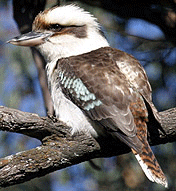 Laughing
Kookaburra
Laughing
Kookaburra
-
Laughing
Kookaburra
-
it
is white and brown with some blue and grey on
their wings
-
is
found throughout eastern Australia
-
and has been introduced into Western Australia,
Tasmania, and Flinders and Kangaroo Islands.
-
Blue-Winged
Kookaburra
-
The Blue-winged kookaburra has a large blue
patch on the wings.
-
The head and chest are fluffy and covered with
light coloured feathers, the rump and wings are
coloured bright blue and it has some brown
feathers above its dark blue tail .
-
Has a large, cream-white head that is streaked
brown.
-
It
has a brown back and its wings are mostly blue.
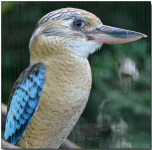 Blue-Winged
Blue-Winged
-
The rump
and tail are also blue on the male, but the
female has a reddish-brown barred tail.
-
They have a very pointy long beak.
-
Differences from Laughing Kookaburra are:
blue rump, cream-white head and light eye
colour.
-
It is
found in southern New Guinea and the wetter
parts of northern Australia, across Queensland and the top part of Australia and down the coast
of Western Australia.
-
It
lives in the Mangrove swamps of Northern
Australia
-
and
has a preference for aquatic food such as fish,
freshwater crayfish, frogs, waterworms and small
crabs.
-
The Blue-winged Kookaburra has a call which sounds
like a barking cough
- like its cousin welcomes the sun in the morning but
with a call
which sounds a little like 'Ow Ow Ow'.....
-
Rufous-bellied
Kookaburra ►

-
is
found mainly in New Guinea rainforests, living
pairs rather than family groups .
-
Spangled
Kookaburra
(Aru
Giant Kingfisher)
-
Very
little is known about this species, which is
found only on the
Aru Islands
and in southern New Guinea.
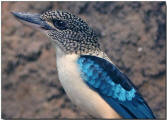 Spangled Kingfisher
► ►
►
Spangled Kingfisher
► ►
►
Distribution and Habitat:
- The
Laughing Kookaburra is native to eastern Australia
- but
over the past century it has been introduced and
established in other parts of the continent and on off
shore islands such as Tasmania.
- The
Kookaburra is a member of the subfamily Daceloninae, the
forest or wood kingfishers.
-
Laughing Kookaburras and Blue-winged Kookaburras live in
woodlands and open forests.
-
Species in this group are not restricted to riparian
(waterways) habitats and hunt
primarily over land.
- They
inhabit open woodlands, forests, orchards, parkland,
partially timbered farmland, and even
suburbs and towns.
-
Kookaburras live in nearly all of Australia except the
dry interior.
- They
live in family groups of parents and their chicks.
- The
chicks of varying ages help feed the new nestlings.
- They
claim their territory with their laughing calls.
-
Kookaburras lay 2-6 eggs.
-
Their nests are built in hollow branches of trees.
DIET in
the WILD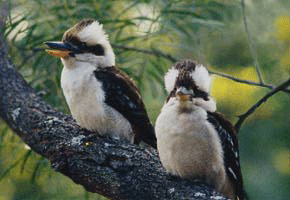 Laughing
Kookaburras
Laughing
Kookaburras
-
Kookaburras use their strong beaks to catch a wide
variety of prey
- Their
claws, in comparison to other Birds of Prey, are not as
strong.
- Their
diet includes lizards, snakes, worms, earthworms and
insects.
-
Sometimes they eat rats and small birds.
- They
also eat mice, fish, frogs and other small animals.
-
In times
of grasshopper or mouse
plagues in the wild,
-
their diet will consist almost entirely of these
animals.
-
Kingfishers employ a "sit and wait" technique of
hunting, surveying their surroundings from an
advantageous perch,
-
then swooping down to seize their prey.
-
Small prey are killed directly by the crushing
action of the bill.
-
Larger prey, including snakes of up to 1 meter in
length, may be whacked repeatedly against a branch
or dropped from a height until pulverized.
-
Prey items include large insects, lizards, snakes,
amphibians, small mammals, birds, and occasionally
fish.
DIET in
CAPTIVITY
- The
need a varied, high protein, carnivorous diet similar to
that of a Bird of Prey or Owl
- In a
Zoo Environment, they are fed commercially prepared "Bird
of Prey mix" and dead, day-old chicks.
How
it Catches its Food
-
the Kookaburra uses a "wait-and-pounce technique",
- -
taking up a post with a good view.
-
When prey appears, the Kookaburra drops straight
down from its perch,
-
its wings back, with beak ready to grab
its dinner.
-
Large prey items like lizards and snakes are bashed
against a tree or a rock,
-
to
kill them and soften them up before they are
eaten.
- Adult
Ks bash their prey on a perch to break up the bones
and make it easier to eat
-
It
also serves to "tenderise" the meat of the prey.
-
Feathers
and fur from their meals provide roughage
-
while
the bones & insect shells provide the calcium
-
Can devour snakes up to 3 ft in length.
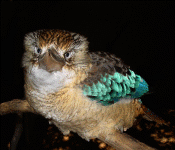 Blue-Winged Kookaburra
Blue-Winged Kookaburra
- They
even continue with the "Bashing of Food" ritual in
captivity when "Dead" food is fed to them
- As
it still serves the purpose of tenderising the flesh
and pulverising the bones
-
Kookaburras
are NOT closely associated with WATER -
HOWEVER:
-
They DO like to bathe
-
and will sometimes catch fish with plunging
dives and, on occasion, raid suburban goldfish
ponds.
- Prey is stunned by dropping from a height or
whacking it against a branch before swallowing.
- They will even kill poisonous snakes by grabbing
them behind the head and smashing them
against a
rock until they are dead.
-
They
regurgitate a "cast" once per day of undigested
material in the form of a "dry" pellet
-
(a
bit like an owl does).
-
The "Casts" resemble mammalian Droppings! (Nice eh?!"!")
-
If
they get stressed they will regurgitate their meal -
even hours later.

-
One of the rarest Kingfishers in the world (there
are now only about 50 individuals
left in the wild of this critically endangered
species) is the Tuamotu Kingfisher
►
►
PROBLEMS with PESTICIDES in the Wild
-
When humans use pesticides to kill insects
-
they end up poisoning the animals which usually feed
on those pests.
-
When kookaburras eat contaminated insects,
-
they absorb the pesticide chemicals and store them
in their fat.
-
When food is in short supply and the kookaburras use
some of their fat store,
-
high concentrations of chemicals may flow into
the blood.
-
The result can be reproductive losses or even
death.
-
If
you must use Pesticides, choose the least toxic
ones
-
and take special care to avoid those which
build up residues in the bodies of animals
which prey on insects.
A
KOOKABURRA's CROP
-
A
Kookaburra's crop is between it's legs
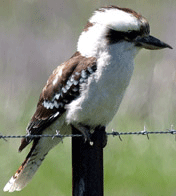 Laughing Kookaburra
Laughing Kookaburra
-
so
if you had to force feed (or hand-feed a baby)
-
allow extra time for the food to get as far down
as the crop.
-
-
you have to push the food a little more the back
of their mouths
-
Scissor-type of tweezers are ideal for feeding
like this to prevent getting bitten.
-
Food should be moistened first
-
Dip it in water first
-
This will help the food slide down the
throat easier.
-
as
they also have
very short tongues
-
HOUSING
-
Must
be housed separately - if put in with other birds
esp. smaller ones - they may eat them.
-
However,
they do like to be
within sight or sound of other Kookaburras
-
and may not
"LAUGH" unless with or near their own breed.
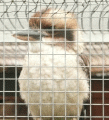
-
The
need a long Aviary, as they need lots of Flying
space.
Conservation status:
- All
four species are listed as being of 'least concern'.
The Name
"Kookaburra" & other Idiosyncrasies about them
- comes
from an Australian Aboriginal word of the Wiradjuri
people, "guuguubarra",
-
which sounds like the laughing call the birds make.
- The
aborigines also believed that any child who insulted a
kookaburra would grow an extra slanting tooth.
- An
Aboriginal legend says that the Kookaburra's laugh is a
signal to the sky spirits to light the great fire,
the sun, in the morning and to put it out at night.
DESCRIPTION : Laughing
Kookaburra
Laughing
Kookaburra
-
Kookaburras have short, thick bodies, large heads and
long bills.
- Their
feathers are brown, black or white.
- There
are blue patches on some of the feathers.
- Males
and females look similar.
Their
Distinctive Call or LAUGH
-
Kookaburras make a laughing call,
- most
often in the early morning and just before dark.
- The
calls let other Kookaburras know where each one lives.
- The
Laughing Kookaburra and the Blue-winged Kookaburra live
in family groups.
- One
will make the chuckling sound that is the start of the
call.
- and
the others join in,
- The
most famous feature of the species is its loud,
boisterous "laugh", a repeated "kook-kook-kook-ka-ka-ka"
call that rises and falls in volume as family members
join in to form a raucous chorus.
- Often
heard at dawn in the bush,
-
this call has provided the Laughing Kookaburra with
another one of its colourful nicknames,
CALLS
BREEDING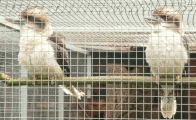 Laughing
Kookaburras
Laughing
Kookaburras
- They
are sexually mature around 12 months of age
- They
usually only have one clutch per year.
-
Kookaburras
begin their breeding cycle in October, the Australian
springtime.
-
Courtship includes vocalizations and conspicuous display
flights high over the treetops.
- Once a
pair selects a breeding territory they begin nest
construction.
- Both
male and female participate in excavating a nest burrow.
- In
some parts of Australia, Termites construct enormous
clay mound nests high in Acacia trees.
- These
arboreal termite mounds seem to be the preferred nest
site for Kookaburras and other kingfisher species.
- They
will also utilize hollow trees, earthen banks, and even
holes in walls when better sites are unavailable.
-
Burrows may be two feet deep with an entrance hole four
inches in diameter.
- After
mating, the female Kookaburra lays 2 -4 white eggs,
EVERY OTHER DAY
-
about the size of a
Bantam chicken egg,
in
a hole in a tree.
- they
are laid on the bare substrate of the nest chamber
naturally occurring tree hollow
-
or in a burrow excavated in an arboreal
(tree-dwelling) termite mound.
- The
male and the female take turns to sit on the
eggs until they hatch,
- During the
25- to
29-day incubation.
- Both parents feed their chicks.
- Both sexes share the incubation duties and both care
for the young.
-
Incubation begins with the first egg laid - of up
to four.
- Feeding of young is carried out by all members of
the group.
- The young leave the nest 30 days after hatching,
- but the parents continue to feed them for another 40
days.
- Baby Kookaburras are called PULLUS
- The
young depend on their parents for several months
-
3
months being the average
- Laughing Kookaburras are believed to pair for
life
and have an
unusual parenting
behaviour.
- Other Laughing Kookaburras, usually offspring of the
previous one to two years, act as 'helpers'
during
the breeding season.
- Every bird in the group shares all parenting duties.
- After
the young are reared and fledge they often stay around
the nest to help the parents with
the next clutch of babies.
- This
behaviour contrasts dramatically with the majority of
birds who leave the nest once they are fledged to search
for territory and mates of their own.
- When a
Kookaburra family-system of chick rearing has been
established it is usual for a second clutch of chicks to
be raised in one season.
- In
this instance, the offspring of prior clutches will take
over the raising of the first brood of the season while
the parents attend to the second.
- In a
Kookaburra family group all the birds develop a brood
patch which is a bare spot of skin on the
breast used to transfer body heat to incubate the eggs.
- There
have been documented cases where the
helper birds
spend more time incubating eggs than
one of the parents.
- Most
helpers are males who assist with nesting duties as well
as territory defence.
- If a
parent dies often a helper will take the place of the
missing mate.
THE
CHICKS
-
Hatchlings emerge blind and practically naked.
- The
eyes may not open completely until the bird is nearly
three weeks old.
- by 16
days they are starting to develop their pin feathers
-
Parents feed the young a diet consisting primarily of
insects + poss. mealworms.
- as
they remain within the burrow for a full month.
-
When they finally are coaxed from the nest they are
already able to fly.
-
The parents continue to feed the fledglings for
several weeks after they emerge from the nest.
-
The birds will remain together as a family group
until the next breeding season begins.
-
You will know your Kookaburra is still under 3
months old if it's beak is still ALL BLACK.
-
HAND-REARING can be carried out
- At
about four weeks of age,
- So
the early part of rearing is done by the Adults
 ^Top
^Top |
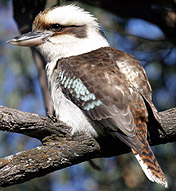
 Blue-Winged
Kookaburra
Blue-Winged
Kookaburra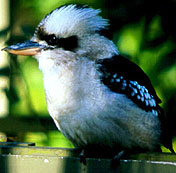

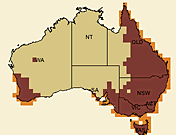
 Laughing
Kookaburra
Laughing
Kookaburra


 Laughing
Kookaburras
Laughing
Kookaburras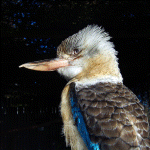


 Laughing Kookaburra
Laughing Kookaburra
 Laughing
Kookaburra
Laughing
Kookaburra